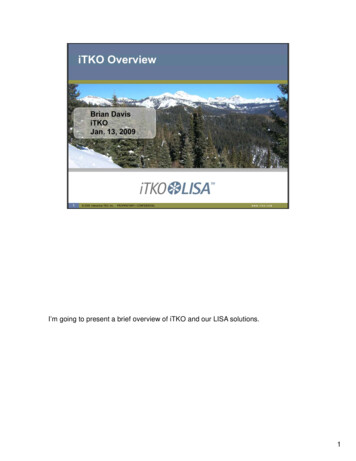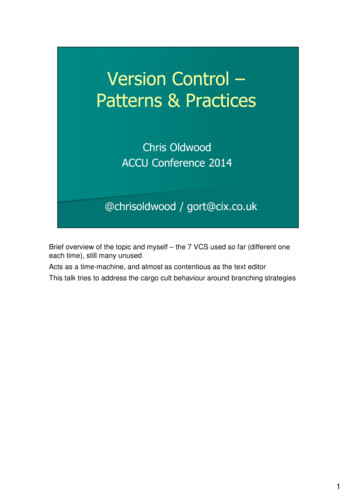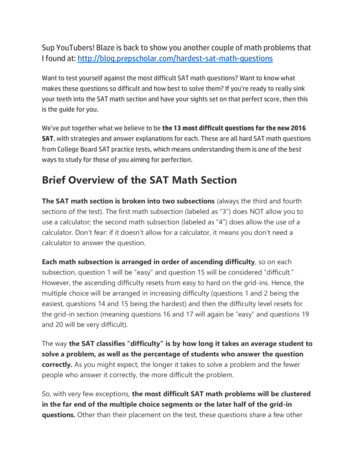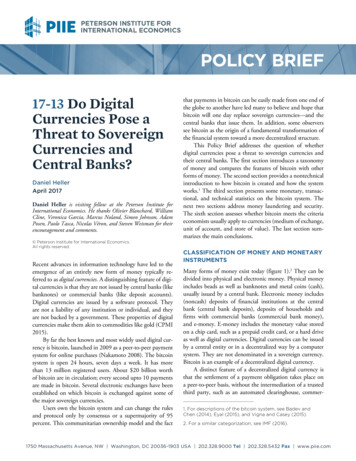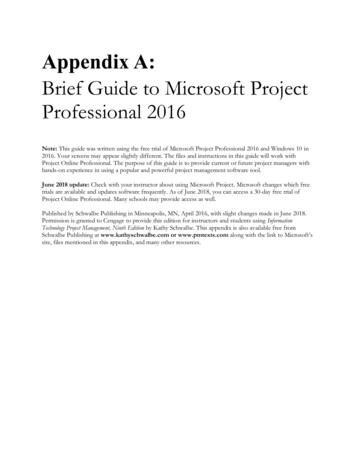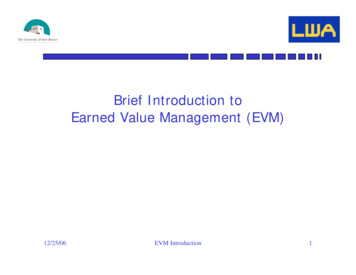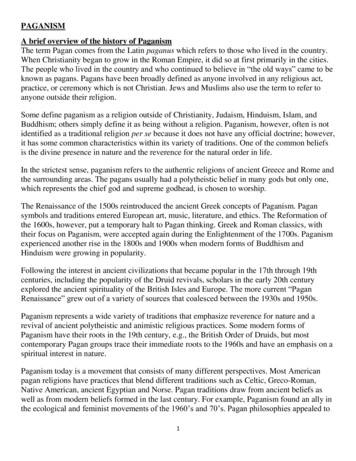
Transcription
PAGANISMA brief overview of the history of PaganismThe term Pagan comes from the Latin paganus which refers to those who lived in the country.When Christianity began to grow in the Roman Empire, it did so at first primarily in the cities.The people who lived in the country and who continued to believe in “the old ways” came to beknown as pagans. Pagans have been broadly defined as anyone involved in any religious act,practice, or ceremony which is not Christian. Jews and Muslims also use the term to refer toanyone outside their religion.Some define paganism as a religion outside of Christianity, Judaism, Hinduism, Islam, andBuddhism; others simply define it as being without a religion. Paganism, however, often is notidentified as a traditional religion per se because it does not have any official doctrine; however,it has some common characteristics within its variety of traditions. One of the common beliefsis the divine presence in nature and the reverence for the natural order in life.In the strictest sense, paganism refers to the authentic religions of ancient Greece and Rome andthe surrounding areas. The pagans usually had a polytheistic belief in many gods but only one,which represents the chief god and supreme godhead, is chosen to worship.The Renaissance of the 1500s reintroduced the ancient Greek concepts of Paganism. Pagansymbols and traditions entered European art, music, literature, and ethics. The Reformation ofthe 1600s, however, put a temporary halt to Pagan thinking. Greek and Roman classics, withtheir focus on Paganism, were accepted again during the Enlightenment of the 1700s. Paganismexperienced another rise in the 1800s and 1900s when modern forms of Buddhism andHinduism were growing in popularity.Following the interest in ancient civilizations that became popular in the 17th through 19thcenturies, including the popularity of the Druid revivals, scholars in the early 20th centuryexplored the ancient spirituality of the British Isles and Europe. The more current “PaganRenaissance” grew out of a variety of sources that coalesced between the 1930s and 1950s.Paganism represents a wide variety of traditions that emphasize reverence for nature and arevival of ancient polytheistic and animistic religious practices. Some modern forms ofPaganism have their roots in the 19th century, e.g., the British Order of Druids, but mostcontemporary Pagan groups trace their immediate roots to the 1960s and have an emphasis on aspiritual interest in nature.Paganism today is a movement that consists of many different perspectives. Most Americanpagan religions have practices that blend different traditions such as Celtic, Greco-Roman,Native American, ancient Egyptian and Norse. Pagan traditions draw from ancient beliefs aswell as from modern beliefs formed in the last century. For example, Paganism found an ally inthe ecological and feminist movements of the 1960’s and 70’s. Pagan philosophies appealed to1
many eco-activists who also saw nature as sacred and recognized the Great Goddess as MotherNature.Recommended readingsPaganism: An Introduction to Earth-Centered Religions by Joyce and River Higginbotham;Llewellyn Publications; first edition, 2002. Presents the fundamentals of Paganism. It exploresthe Pagan sacred year, rituals, and Pagans beliefs about God, worship, human nature, and ethics.Drawing Down the Moon by Margot Adler; Penguin Books; Revised edition, 2006. An updatedresource guide of newsletters, journals, books, groups, and festivals as well as an in-depth lookat the beliefs, experiences and lifestyles of modern America's Pagan groups.The Triumph of the Moon by Ronald Hutton; Oxford University Press, 2001. This book hasbeen described as bringing witchcraft “out of the shadows.” While it explores the “dark side ofwitchery,” it stresses the positive, reminding readers that devotion to art, the natural world, andfemininity are central to the practice of Wicca.The Basic Beliefs of PaganismBecause of the wide diversity in Paganism, there are a variety of resources about its basicbeliefs. In general, Pagans celebrate nature and spirituality and encourage an eco-friendlylifestyle. Equality of the sexes is dominant. Women play a significant role in ceremonies andgoddesses are of great importance. Pagans believe that there is divinity in the living world and,through rituals, they can connect with the divine. The festivals are related to their devotion tonature; e.g., the Summer Solstice celebrates the sun and the divinity that creates life.Source: Paganism: Types of Religion (http://www.typesofreligion.com/paganism.html)The following three items, taken together, provide a comprehensive overview of the basicbeliefs.(1) Basic Principles of Paganism. Although principles vary from one pagan religion toanother, most pagan religions follow the same general set of principles in some form.-- Responsibility of Beliefs. “The most basic tenant of paganism is that it is your ownresponsibility, not the responsibility of any government, institution, church or other people tochoose what you believe in regards to spirituality, values, ethics, the nature of Divinity, etc.”-- Personal Responsibility for Your Actions and Personal Development. “The development ofyour personal beliefs, morals and ethics is your own responsibility . it is the responsibility ofeach individual to learn to recognize what is right from wrong, regardless of our earlyenvironment.”-- Everything is Sacred. “Most pagan religions believe that everything in the universe is sacred,but the definition and level of sacredness applied to an object will generally vary from onepagan to another. For some pagans, all parts of our universe are considered divine and, as such,sacred and worthy of our deepest respect.”-- Freedom of Choosing Deity. “In all pagan religions, it is up to the individual to determine2
what Deity means to them, who or what Deity is right for them and how they ultimately developtheir relationship with their chosen Deity. Pagans have many different ideas about whatencompasses Deity and how their Deity is represented. It is up to the individual, through studyof their religion, meditation and, in some cases prayer, to determine what image of Deity isright for them.”-- Scope of Consciousness. Many traditional pagans “believe that consciousness extends farbeyond the restraints of human form and physical existence. All life forms contain some levelof consciousness, from the smallest insect to the giant redwood trees.consciousness survivesdeath and exists simultaneously on multiple levels of reality.”“Since the term paganism is something of an ‘umbrella’ term, used to cover a wide range ofspiritual paths, it would be virtually impossible to provide a detailed and comprehensive list ofprinciples that apply to all pagan religions. For the most part however, these very basicprinciples can be found in almost all forms of paganism.”Source: “What are some of the basic principles of es-ofpaganism-2192.html)(2) What Contemporary Pagans Believe . “The central beliefs of modern Pagans differ inspecifics yet share many fundamentals. Deity is seen as immanent rather than transcendent.Experience is preferred over doctrine. It is believed that there are and should be multiple pathsto the Divine.While there is no set of beliefs shared by all Pagans, most would agree thatsimilarities far outweigh differences. There are a number of beliefs held by the vast majority ofmodern Pagans.” For example:-- Multiple paths to the divine exist as symbolized by many goddesses and gods. These areoften seen as archetypes or gateways to the unconscious.-- Respect and love Mother Earth essentially as a living being.-- The physical world, as an emanation of the divine, is good and to be enjoyed by all livingbeings in love and harmony.-- Ethics and morality are based on avoidance of harm to other beings, including Earth as awhole, which mandates environmental activism as a spiritual responsibility.-- Human interdependence implies the need for community cooperation.-- A strong commitment to personal and planetary growth, evolution, and balance are vital.-- One's lifestyle must be consistent with one's beliefs.-- A minimum of dogma and a maximum of individual responsibility in all things are goals tostrive for. Thus a healthy skepticism is to be fostered, and ideas are not to be accepted withoutpersonal investigation of their validity.-- All beings are personal emanations of the Divine.Source: Modern Paganism (http://www.paganlibrary.com/introductory/modern paganism.php)(3) The three principles of the Pagan FederationThe principles are intended “to provide a general outline of some key mainstream Paganattitudes and beliefs concerned with how we relate to the Earth, how we relate to others, and3
how we relate to the divine.”-- Love for and Kinship with Nature. This principle recognized that “human beings are partof nature and that our lives are intimately interwoven with the web of life and death.”-- A positive morality “in which the individual is responsible for the discovery and developmentof their true nature in harmony with the outer world and community. This is often expressed as‘Do what you will, as long as it harms none.’”-- Recognition of the Divine, which transcends gender, acknowledging both the female andmale aspect of Deity.Source: The Pagan Federation (http://www.paganfed.org/about-princ.shtml)(Note: The Pagan Federation International includes members from the United States and acrossthe world.)The Key Principles of humanismNumerous statements by both organizations and individuals express the principles of humanismand include our shared worldview with Paganism which can be summed up in one word,naturalism: “the system of those who find all primary causes in nature.”“Secular humanism is philosophically naturalistic. Naturalism asserts that supernaturalentities like God do not exist, and warns us that knowledge gained without appeal to the naturalworld and without impartial review by multiple observers is unreliable.” -- Council for SecularHumanism �There is no divine realm. Of course there are strange or as yet unanswered questions about theworld, but when we really know or understand the answers then these phenomena are alwaysbrought into the natural world or under the laws of nature .” -- The International Humanistand Ethical Union Since the word ‘humanism’ can be used in different ways, we often add the adjective‘naturalistic’ to suggest a self-sufficient worldview that does not require the intervention of anydeity. However, some naturalists, past and present, have attached non-traditional meanings tothe definition of God, for example, Spinoza: “God is nature but exhibits no will, no purpose, nodesign.” Some humanists concede that a poetic or non-traditional usage of the word need notconflict with Naturalism -- the claim that any process in the universe can be explained withoutrecourse to non-natural forces.” -- The Humanists of .html)“The only reality is what we can detect through our senses – can see, hear, touch and so on – orelse detect by the use of scientific instruments. There is no ‘second layer’ to existence – nogods and ghosts, no souls or spirits of the place – and our only route to sure and certain .knowledge is through an assumption of naturalism.” -- “Humanism: Beliefs and Values”;David Pollock, British Humanist Association and European Humanist umanism-beliefs-and-values/)4
We also suggest that you go to the sources noted below for a more complete presentation of thekey principles of humanism. The principles cover a wide array of humanist concerns. We havedrawn from several statements.From Humanist Manifesto I (1933)-- In place of the old attitudes involved in worship and prayer, the humanist finds his religiousemotions expressed in a heightened sense of personal life and in a cooperative effort to promotesocial well-being.--The goal of humanism is a free and universal society in which people voluntarily andintelligently cooperate for the common t Manifesto I)From Humanist Manifesto II (1973)-- From the Preface: “Humanism is an ethical process through which we all can move, aboveand beyond the divisive particulars, heroic personalities, dogmatic creeds, and ritual customs ofpast religions or their mere negation.”-- From the Closing: “We will survive and prosper only in a world of shared humane values.At the present juncture of history, commitment to all humankind is the highest commitmentof which we are capable.” (http://americanhumanist.org/Humanism/Humanist Manifesto II)From Humanist Manifesto III: Humanism and Its Aspirations (2003)“.Thus engaged in the flow of life, we aspire to this vision with the informed conviction thathumanity has the ability to progress toward its highest ideals. The responsibility for our livesand the kind of world in which we live is ours and ours anist Manifesto III)From the Amsterdam Declaration 2002 (International Humanist and Ethical Union)-- Humanism is a lifestance aiming at the maximum possible fulfillment through the cultivationof ethical and creative living and offers an ethical and rational means of addressing thechallenges of our times. Humanism can be a way of life for everyone -declaration/)From “What Is Humanism?” by Fred EdwordsFormer AHA Executive Director and currently the director of the United Coalition of Reason,Fred Edwords has written prolifically about the principles of humanism. In an essay on What IsHumanism? he concludes with a keen observation: “So, with modern humanism one finds alifestance or worldview that is in tune with modern knowledge; is inspiring, socially conscious,and personally meaningful. It is not only the thinking person's outlook but that of the feelingperson as well, for it has inspired the arts as much as it has the sciences; philanthropy as muchas critique. And even in critique it is tolerant, defending the rights of all people to choose otherways, to speak and to write freely, to live their lives according to their own lights. So the choiceis yours. Are you a humanist? You needn't answer ‘yes’ or ‘no.’ For it isn’t an either-orproposition. Humanism is yours -- to adopt or to simply draw from. You may take a little or a5
lot, sip from the cup or drink it to the dregs. It’s up to you.”(http://americanhumanist.org/humanism/What is Humanism)Helen Bennett describes her personal views in her poem “What Humanism Means to Me” in herbook, Humanism, What’s That? A Book for Curious Kids (Prometheus Books, Amherst, NY,2005).Humanism means to meI’ve got the opportunityTo realize that I am freeTo take responsibility.To me, it doesn’t seem so oddThat many people pray to GodWhenever they are feeling low -It’s just the way they have to go.But when I do not know the wayI do not feel the need to pray.I use my brain to figure outWhat the problem’s all about.I’m grateful that I have my eyesTo see the beauty of the skies,I’m glad I have my ears to hearThe voices of my friends so dear.But best of all, my brains the oneThat figures out what must be doneTo help me run a better race,To make the world a better place.For additional essays on Living the Humanist Life, Humanism and Traditional Religion andrelated issues, see: http://americanhumanist.org/Who We Are/About HumanismTypes of Paganism. The website, Lost Civilizations nism-page-4.html) has defined the following types of Paganism:Paleo-paganism: the standard of paganism, a pagan culture which has not been disrupted by‘civilization’ by another culture, e.g., ancient Celtic religion (Druidism); religions of the prepatriarchal cultures of Old Europe, Norse religion, pre-Columbian Native American religions,etc.6
Civilo-paganism: the religions of ‘civilized’ communities which evolved in paleo-pagancultures: Classical Greco-Roman religion, Egyptian religion, Middle-Eastern paganism, etc.Meso-paganism: a group, which may or may not still constitute a separate culture, which hasbeen influenced by a conquering culture but has been able to maintain an independence ofreligious practice, e.g., many Native American nations.Syncreto-paganism: similar to meso-pagan but having had to submerge itself into the dominantculture and adopt the external practices and symbols of the other religion, like the various Afrodiasporic traditions.Neo-paganism: attempts to reconnect with nature, using imagery and forms from other types ofpagans but adjusting them to the needs of modern people. Some examples: Wicca -- in its manyforms; neo-Shamanism; neo-Druidism; Asatru and other forms of Norse neo-paganism; neoNative American practices; the range of practices labeled ‘Women's Spirituality.’Modern Paganism has been described in this way: “In the present day, the Pagan traditionmanifests both as communities reclaiming their ancient sites and ceremonies (especially inEastern Europe), to put humankind back in harmony with the Earth, and as individuals pursuinga personal spiritual path alone or in a small group . under the tutelage of one of the Pagandivinities. To most modern Pagans in the West, the whole of life is to be affirmed joyfully andwithout shame, as long as other people are not harmed by one’s own tastes.” Source: PaganFederation International In addition, there are other Pagan belief systems which are highly relevant: Secular Paganism,Naturalistic Paganism, and Humanistic Paganism.Secular PaganismSecular Paganism is a set of principles shared by diverse groups around the world. It is a naturaloutgrowth of many peoples’ personal ethics and beliefs about life. It is not a religion but ratheran ethical view based on the belief that nature is sacred and must be respected and treasured.Secular Pagans believe that we are a part of nature, not her master. There are no particularreligious views connected with Secular Paganism. While there is no organization or groupdesignating these beliefs, there are commonly held principles.There are many reasons why people call themselves Secular Pagans. Many have a deep andabiding love for the natural world and the environment. Many believe that all things in naturehave a spirit or soul that is unique to them. Many are people whose ethical code is built on theirrespect for Earth and the environment. Many are scientists who have come to the belief throughtheir research. Secular Pagans include environmentalists, farmers, academics, retail workers,scientists, students, artists, performers, teachers, laborers, writers, teenagers and children. Manyare atheists or agnostics. Meditating on nature and one’s place in it is a ritual of many SecularPagans as is protecting the environment.7
It is not the belief in a deity that unites Secular Pagans but rather a belief in the 15 GuidingPrinciples of Secular Paganism. Some of which are:-- Ethical behavior does not require a religion-- The equality of genders, races, and all humans-- Our health depends on the Environment's health-- Our individual actions can and do have consequences-- Evolution is an ongoing process that occurs in all species-- Respect for ourselves requires respect for the Earth-- Gods and Goddesses can be seen as metaphorsSource: For the entire list, see: Secular ism.html)Naturalistic Paganism“Naturalistic Pagans support the view of the world that includes those things which one canobserve or conclude from observations. Their conception of reality consists of the natural worldas supported by scientific understanding. As for claims for which there is no evidence, Pagannaturalists maintain that ‘We are careful to limit our claims about reality to what we canexperience and measure . On all else, we are content to admit ‘we don’t know.’” Source:What is Spiritual Naturalism? at-is-spiritualnaturalism/)“Philosophical naturalism seeks to explain the universe without resort to supernaturalcauses. For most Naturalistic Pagans, ‘naturalistic’ is synonymous with ‘scientific.’ In general,they adopt the most current explanations of science and are skeptical of claims not supported byscience. Naturalistic Pagans are skeptical about things like magic(k), psychic abilities,communication with spirit entities, attributing intention to inanimate nature . To the extentthat Naturalistic Pagans speak about ‘magic’ or ‘gods’, they tend to use these words differentlythan their common usage. Naturalistic Pagan . may understand ‘gods’ as metaphors fornatural phenomena.” Source: What is Humanistic/Naturalistic sm/)In short, Naturalistic Paganism integrates mythic, meditative, and ritual practices with aworldview based on the most compelling scientific evidence.A paper by the Spiritual Naturalist Society (http://spiritualnaturalistsociety.org/) raises anumber of relevant questions which we have abstracted below.-- What defines us? “First, we are Pagans. Our spiritual practices are inspired by ancient nonAbrahamic cultural-religious traditions . we draw inspiration from old ways while embracingmodernity. Second, we are naturalists. This worldview unites our many varieties and makes usunique among Pagans. What most Naturalistic Pagans mean by it can be summed up simply:‘only natural causes affect the universe; if there are supernatural causes, there is no reliable8
evidence yet to support that idea.’ . natural causes are best discovered via the current mostcompelling scientific evidence. . we adopt an appropriate skepticism toward any supposeddivine or magical causes outside nature, i.e., supernatural causes as well as those within natureunsupported by the best evidence.”“While we find little evidence to support most of the metaphysical claims made for deities andmagic, we find plenty of evidence for the capacity of Pagan myth, meditation, and ritual. As aresult of our reliance on demonstrable evidence, several tendencies emerge, including thesetwo: (1) We tend to view deities as metaphorical, poetic, or psychological in some sense, andnot as causal agents external to and independent of the individual. (2) Because our worldviewdoes not include afterlives or hidden realms, we tend to be focused on life. cherishing eachmoment and improving the world for all life on Earth.”-- Practices. “Although there is great variation, some common practices include: exploringmythology for inspiration and insight; discovering our world through experience and scientificinquiry; and changing ourselves and our society through responsible action. . we may invokedeities although the meaning may be allegorical.”-- The role of science. “Faith claims, extra-sensory perceptions, personal visions, and the likehave proven unreliable as guides to reality. scientific method, though imperfect, has proventhe most reliable to date. we look to the current most compelling scientific evidence.”-- The role of Paganism. “Pagan myth, meditation, and ritual cultivate a nature-based, richlysymbolic subjective experience. those who come to feel more akin to the environment aremore likely to protect it.”Source: Spiritual Naturalist Society anisticpaganism/)Humanistic PaganismHumanistic Paganism, as well as Naturalistic Paganism, describes the Pagan path for those whoare uncomfortable with or skeptical of the supernatural or metaphysical elements ofcontemporary Paganism. They are Pagans who are firmly rooted in the physical world.Humanistic Paganism “is a naturalistic path rooted in ancient Paganism and contemporaryscience.” -- Source: Humanistic Paganism ganism-2-0/)“Humanistic Paganism is a form of religious or spiritual humanism. Religious humanism candescribe any religion that takes a human-centered ethical perspective as contrasted with a deitycentered ethical perspective. What is good is defined in terms of human experience rather thanthe will of any god or gods. Religious humanists tend to be atheistic or non-theistic. Forreligious humanists, human experience and reason provide a more than sufficient basis forethical action without supernatural revelation. Humanistic Paganism can embrace the notionthat we humans are part of a much larger community of beings to whom we have ethicalobligations. The adjective ‘humanistic’ is intended to contrast with ‘theistic’; it excludes gods,but not other living beings.” -- Source: “What is Humanistic/Naturalistic Paganism?”9
r those who struggle with anti-pagan prejudices and stereotypes, Humanist Paganism mightbe a powerful educational tool. It can show that a pagan can be a sophisticated, cosmopolitan,and enlightened person, and that a pagan culture can be artistically vibrant, environmentallyconscious, intellectually stimulating, and socially just.” -- Source: Brendan Myers, an authorknown for his contributions in environmental philosophy, Druidry and Neo-Druidism,mythology, and applied virtue /brendanmye616110.html)“. Humanistic Paganism is a naturalistic way of life rooted equally in science andmyth. Modern empirical science has revealed a startling universe that is a wonder to behold,and we have every reason to stand in awe. At the same time, the world’s ancient mythictraditions reveal our inner, psychological universe. Both are valuable in the 21stcentury. When it comes to science and religion, there’s no reason to throw the baby out withthe bathwater. One way of life that fully embraces both is Humanistic Paganism.” -- Source:“Exploring Humanism and Paganism with B.T. Newberg” (Cited in “The HumanistContemplative: Essays in Spiritual Naturalism” by D. T. .html) Note: B.T. Newberg is the editor of the website Humanistic Paganism.Humanistic Paganism. The mission of the website, HumanisticPaganism.com, “is to amplify thevoices of Pagans engaged in naturalistic spirituality.” The four goals are “to share reflection onbeliefs and practices, to aid connection with others of like mind, to develop and debate a Pagannaturalistic way of being-in-the-world, and to educate other Pagans and the general public aboutnaturalistic spirituality.” The website includes a section on activism which begins with thisancient Greek proverb: “Hermes will help you get your cart unstuck, but only if you push.” “Inother words, if you want the world to change, you would best begin with your own two hands.”They also provide “resources to help you in your quest to live responsibly”. The resources arein environment and green living, humanitarian concerns, gender issues, and interfaith dialogue.In many ways, we are on “the same page” as you will see in the following quotes, first from thePagan perspective and then the humanist.We Are On The Same Page“We can open new eyes and see that there is nothing to be saved from, no struggle of lifeagainst the universe, no God outside the world to be feared and obeyed.” -- Starhawk, author ofmany works on the Goddess movement and Earth-based, feminist spirituality.“Trees have from time immemorial been closely associated with magic. These stout members ofthe vegetable kingdom may stand for as long as a thousand years and tower far above ourmortal heads. As such they are symbols and keepers of unlimited power, longevity, and10
timelessness. An untouched forest, studded with trees of all ages, sizes and types, is more than amysterious, magical place - - it is one of the energy reservoirs of nature. Within its boundariesstand ancient and new sentinels, guardians of the universal force which has manifested on thethe Earth.” - - Scott Cunningham was an American author of several books on Wicca and otherreligious subjects.“I am a Pagan.I am a part of the whole of Nature.The rocks, the animals, the plants, the elements are my relatives.Other humans are my sisters and brothers, whatever their races, colors, ages, nationalities,creeds, or sexual preferences.The earth is my Mother and the sky is my Father.The sun and moon are my Grandparents, and the stars my ancestors.I am part of this large family of Nature, not the master of it.I have my own special part to play and I seek to play that part to the best of my ability.I seek to live in harmony with others in the family of Nature, treating others with respect, notabuse.”-- Selena Fox is a Wiccan priestess, interfaith minister, environmentalist, pagan elder, author,and lecturer in pagan studies and comparative ************************************“Science makes people reach selflessly for truth and objectivity; it teaches people to acceptreality, with wonder and admiration, not to mention the deep awe and joy that the natural orderof things brings to the true scientist.” -- Lise Meitner was an Austrian physicist and part of theteam that discovered nuclear fission for which she and her colleague were awarded the NobelPrize.“Man is a product of nature, a part of the Universe. The Universe is operated under exactnatural laws. Man is a product of millions of years of evolution. He adapts himself to the lawsof nature or he perishes.” -- James Herve
femininity are central to the practice of Wicca. The Basic Beliefs of Paganism Because of the wide diversity in Paganism, there are a variety of resources about its basic beliefs. In general, Pagans celebrate nature and spirituality and encourage an e


